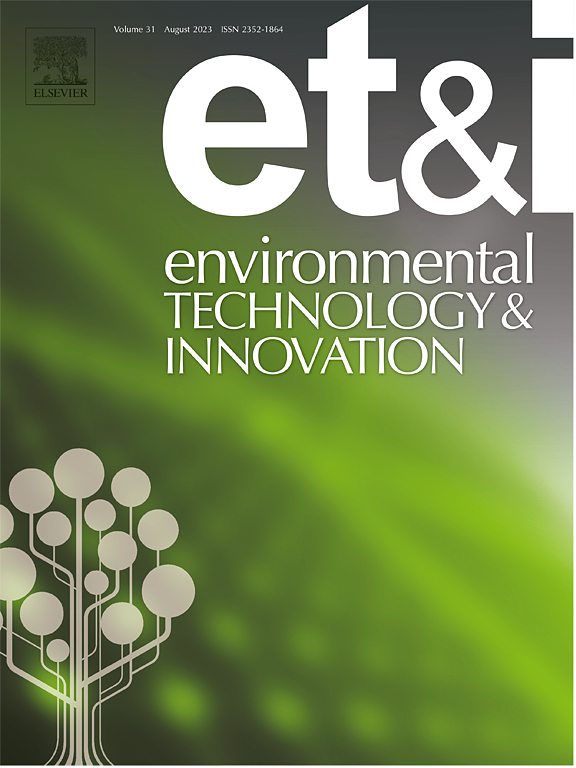同步改善电子供体细菌和电子受体甲烷菌的胞内电子传递,促进餐厨垃圾厌氧消化过程中的种间直接电子传递
IF 6.7
2区 环境科学与生态学
Q1 BIOTECHNOLOGY & APPLIED MICROBIOLOGY
引用次数: 0
摘要
在厌氧消化过程中,有两个主要问题普遍限制了种间直接电子传递(DIET)的有效性:1) 缺乏必要的电连接部件、导电纤毛(e-pili)或多血红素 c 型细胞色素(MHC);2) 电子与质子结合将二氧化碳还原成甲烷的热力学限制。为了解决这两个问题,我们提出了一种在厌氧消化厨余垃圾的过程中将乙醇发酵预处理(EFP)与氯化钠添加相结合来促进 DIET 的策略。将乙醇发酵预处理与氯化钠添加相结合可显著提高甲烷产率(531.3 ± 11.4 vs 410.5 ± 8.7 mL/gVSadded/d)和有机底物转化为甲烷的效率(571.2 ± 13.8 vs 488.7 ± 11.7 mL/gVSremoval)。与单独添加 EFP 或 NaCl 相比,结合添加 EFP 和 NaCl 所提高的性能更高。棕杆菌、 Petrimonas sp.和 Syntrophomonas wolfei 是最主要和代谢最活跃的电子供体细菌,它们的 e-pili/MHCs 基因在 EFP 与 NaCl 添加相结合时的表达量高于单独添加 EFP 或 NaCl 时的表达量。Methanothrix soehngenii 和 Methanoculleus bourgensis 是最主要的代谢活跃的电子接受型甲烷菌,它们的甲烷生成过程中二氧化碳还原途径基因的表达量在 EFP 与 NaCl 复合添加的情况下高于单独添加 EFP 或 NaCl 的情况。此外,EFP 特别增加了与 e-pili/MHCs 形成密切相关的 NAD+/NADH 转化基因的转录丰度,而添加 NaCl 则特别增加了已知参与将二氧化碳还原成甲烷的辅酶 F420/F420H2 转化基因的转录丰度。本文章由计算机程序翻译,如有差异,请以英文原文为准。
Synchronously improving intracellular electron transfer in electron-donating bacteria and electron-accepting methanogens for facilitating direct interspecies electron transfer during anaerobic digestion of kitchen wastes
Two major issues generally limit the effectiveness of direct interspecies electron transfer (DIET) during anaerobic digestion: 1) lack of essential electrical connection component, electrically conductive pili (e-pili) or multi-heme c-type cytochrome (MHC); 2) the thermodynamic limitations of combining electrons with protons for reducing carbon dioxide to methane. To address both issues, a strategy for facilitating DIET via combining ethanol-type fermentation pretreatment (EFP) with NaCl addition during anaerobic digestion of kitchen wastes was proposed. Combining EFP with NaCl addition dramatically increased methane yield rates (531.3 ± 11.4 vs 410.5 ± 8.7 mL/gVSadded/d) and efficiencies of conversion of organic substrates to methane (571.2 ± 13.8 vs 488.7 ± 11.7 mL/gVSremoval). The increased performances by combining EFP with NaCl addition were higher than that by independent EFP or NaCl addition. Paludibacter sp., Petrimonas sp. and Syntrophomonas wolfei were the predominant and metabolically active electron-donating bacteria, and their expression of genes for e-pili/MHCs by combining EFP with NaCl addition was higher than that by independent EFP or NaCl addition. Methanothrix soehngenii and Methanoculleus bourgensis were the predominant and metabolically active electron-accepting methanogens, and their expression of genes for carbon dioxide reduction pathway for methanogenesis by combining EFP with NaCl addition was higher than that by independent EFP or NaCl addition. In addition, EFP specifically increased the transcript abundance of genes for NAD+/NADH transformation closely associated with the formation of e-pili/MHCs, while NaCl addition specifically increased the transcript abundance of genes for coenzyme F420/F420H2 transformation known to participate in reduction of carbon dioxide to methane.
求助全文
通过发布文献求助,成功后即可免费获取论文全文。
去求助
来源期刊

Environmental Technology & Innovation
Environmental Science-General Environmental Science
CiteScore
14.00
自引率
4.20%
发文量
435
审稿时长
74 days
期刊介绍:
Environmental Technology & Innovation adopts a challenge-oriented approach to solutions by integrating natural sciences to promote a sustainable future. The journal aims to foster the creation and development of innovative products, technologies, and ideas that enhance the environment, with impacts across soil, air, water, and food in rural and urban areas.
As a platform for disseminating scientific evidence for environmental protection and sustainable development, the journal emphasizes fundamental science, methodologies, tools, techniques, and policy considerations. It emphasizes the importance of science and technology in environmental benefits, including smarter, cleaner technologies for environmental protection, more efficient resource processing methods, and the evidence supporting their effectiveness.
 求助内容:
求助内容: 应助结果提醒方式:
应助结果提醒方式:


